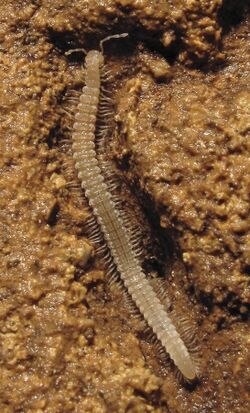Biology:Callipodida
| Callipodida | |
|---|---|

| |
| Tetracion jonesi (Abacionidae), a species from the southern United States | |
| Scientific classification | |
| Domain: | Eukaryota |
| Kingdom: | Animalia |
| Phylum: | Arthropoda |
| Subphylum: | Myriapoda |
| Class: | Diplopoda |
| Superorder: | Nematophora |
| Order: | Callipodida Pocock, 1894 |
| Suborders | |
| |
| Synonyms | |
|
Lysiopetalida Chamberlin, 1943 | |
Callipodida is an order of millipedes containing around 130 species, many characterized by crests or ridges.
Description
Callipodida are long and narrow millipedes, up to 100 millimetres (3.9 in) in length with 40-60 body segments. A dorsal groove is present running down the mid-line of the body, and many species are ornamented with longitudinal crests or ridges.[1][2] Sexually mature males possess a single pair of gonopods, consisting of the modified anterior leg pair of the 7th body segment, and carried concealed within a pouch.[2][3]
Distribution
Callipodida occurs in North America, Europe, west Asia, southern China and Southeast Asia.[4]
Classification
The living (extant) Callipodida are classified into three suborders, seven families, and approximately 130 species.[5] The genus Sinocallipus, which constitutes the suborder Sinocallipodidea, is thought to be the most primitive, and a sister group to all other callipodans.[6] A fourth, extinct, suborder was described in 2019 to accommodate Burmanopetalum inexpectatum, a 99 million-year-old specimen found in Burmese amber.[7]
- Suborder Callipodidea
- Suborder Schizopetalidea
- Abacionidae
- Caspiopetalidae
- Dorypetalidae
- Paracortinidae
- Schizopetalidae
- Suborder Sinocallipodidea
- †Suborder Burmanopetalidea
- †Burmanopetalidae
References
- ↑ "Diagnostic features of Millipede Orders". Milli-PEET Identification Tables. The Field Museum, Chicago. http://fieldmuseum.org/sites/default/files/Identification_Table_1.pdf.
- ↑ 2.0 2.1 Shelley, Rowland M. (1999). "Centipedes and Millipedes with Emphasis on North American Fauna". The Kansas School Naturalist 45 (3): 1–16. http://www.emporia.edu/ksn/v45n3-march1999/. Retrieved 2013-11-14.
- ↑ Stoev, P.; Sierwald, P.; Billey, A. (2008). "An annotated world catalogue of the millipede order Callipodida (Arthropoda: Diplopoda)". Zootaxa 1706: 1–50. doi:10.11646/zootaxa.1706.1.1. http://www.mapress.com/zootaxa/2008/f/z01706p050f.pdf.
- ↑ "Biogeography of Millipede Orders". Milli-PEET Identification Tables. The Field Museum, Chicago. http://fieldmuseum.org/sites/default/files/Identification_Table_2.pdf.
- ↑ Shear, W. (2011). "Class Diplopoda de Blainville in Gervais, 1844". in Zhang, Z.-Q.. Animal biodiversity: an outline of higher-level classification and survey of taxonomic richness. 3148. 159–164. doi:10.11646/zootaxa.3148.1.32. ISBN 978-1-86977-850-7. http://www.mapress.com/zootaxa/2011/f/zt03148p164.pdf.
- ↑ Stoev, Pavel; Enghoff, Henrik (2011). "A review of the millipede genus Sinocallipus Zhang, 1993 (Diplopoda: Callipodida: Sinocallipodidae), with notes on gonopods monotony vs. peripheral diversity in millipedes". ZooKeys (90): 13–34. doi:10.3897/zookeys.90.1291. PMID 21594105.
- ↑ Stoev, Pavel; Moritz, Leif; Wesener, Thomas (2019). "Dwarfs under dinosaur legs: a new millipede of the order Callipodida (Diplopoda) from Cretaceous amber of Burma". ZooKeys (841): 79–96. doi:10.3897/zookeys.841.34991. PMID 31148918.
External links
Wikidata ☰ Q4300405 entry
 |

